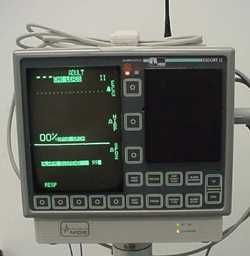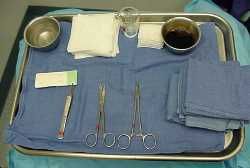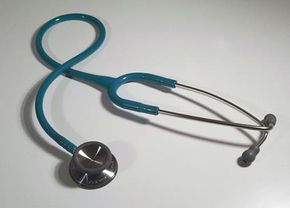Tools of the Trade
Emergency Departments are stocked with a huge array of strangely named, oddly shaped, beeping and blinking equipment. Here's a quick look at a typical lineup.
Stethoscope
A stethoscope doesn't beep or blink, but it is an incredibly useful diagnostic tool. A stethoscope lets a nurse or physician listen to heart and respiratory sounds. One heart sound that can be easily heard with a stethoscope is a heart murmur. The presence of a murmur can be a sign of an abnormal heart valve. Heart sounds are also used to help the physician decide on the rhythm of the heart. If a friction rub is heard, this can be a sign of pericarditis (inflammation around the heart.) Extra heart sounds can be a sign of heart failure.
Advertisement
A stethoscope is also used to listen to the lungs. A physician can diagnose various diseases such as pneumonia, asthma, pneumothorax (collapsed lung), or congestive heart failure this way.
A stethoscope is used to take your blood pressure (BP) by listening to the flow of blood through your arteries. A BP is obtained when a BP cuff is wrapped around your arm and inflated to a pressure high enough to stop the flow of blood in the artery in your arm. The stethoscope is then placed over the artery. Air is slowly let out of the cuff. Blood flow starts when the pressure in the cuff becomes lower than the pressure in the artery. This creates a sound that can be heard with a stethoscope. The pressure on the BP gauge is the upper number in a BP reading. The lower number is the pressure at which the artery is no longer compressed and the sound stops. A normal BP is less than 140 for the upper number (systolic BP) and less than 90 for the lower number (diastolic BP).
Cardiac Monitor

A cardiac monitor gives a visual display of the rhythm of your heart. This is very useful information, particularly during a heart attack when you can suddenly develop a lethal cardiac rhythm. You are connected to the monitor by three sticky patches on your chest, attached to the monitor via wires. Cardiac monitors are set to alarm if your heart rate goes above or below a predetermined number. Some monitors also have an automatic blood pressure cuff and a pulse oximeter (which measures the oxygen saturation of your blood).

Suture Tray
This tray contains the sterile equipment needed to place sutures (stitches) in a patient with a laceration. These include: needle holder (the instrument that holds the needle containing the suture material), forceps (used to hold the lacerated tissue), sterile towels (used to drape off the non sterile areas which are not being repaired), scissors, and small bowls (to hold antiseptic solutions).
Orthopedic Equipment
Most emergency departments have a generous number of orthopedic devices for many purposes. These include plaster and/or fiberglass materials to splint extremities that are fractured or severely injured. You'll also find pre-made splints for specific joints, such as knee immobilizers, aluminum finger splints, Velcro wrist splints, shoulder slings, air splints (for ankles), and cervical collars, as well as cast cutters to use when a cast has become too tight.
Now, let's take a look at a crash cart.
